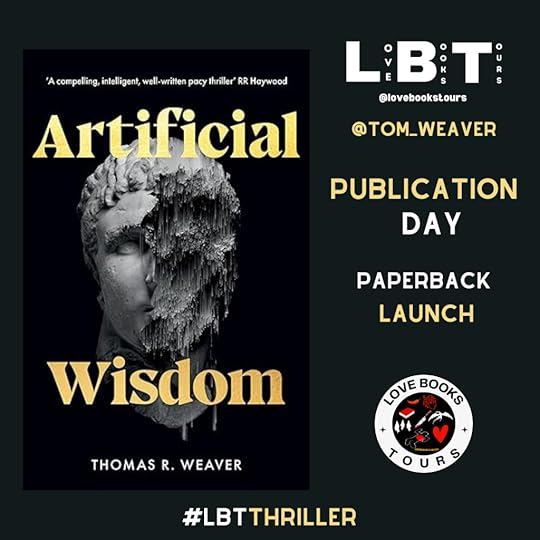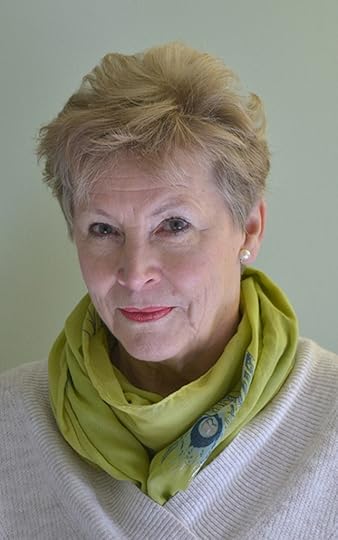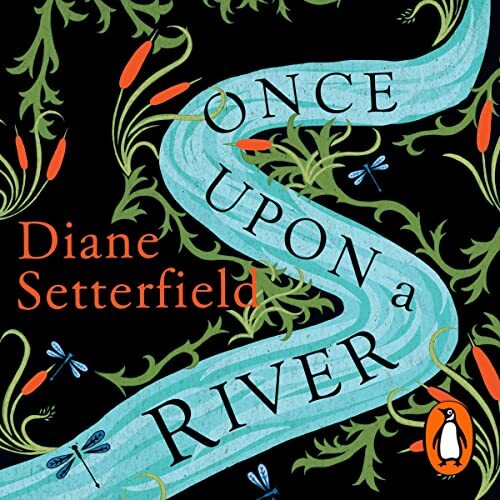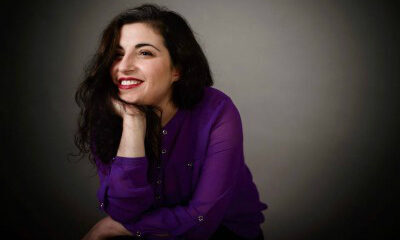Veronika Jordan's Blog, page 31
April 30, 2024
Artificial Wisdom by Thomas R. Weaver Paperback Publication Day
SALVATION HAS A PRICE.
An enthralling murder mystery with a vividly realised future world, forcing readers to grapple hard hitting questions about the climate crisis, our relationship with Artificial Intelligence and the price we would be willing to pay, as a species, to be saved. Perfect for fans of Blake Crouch, Neal Stephenson, Philip K Dick, Kim Stanley Robinson and RR Haywood.
It’s 2050, a decade after a heatwave that killed four hundred million across the Persian Gulf, including journalist Marcus Tully’s wife. Now he must uncover the truth: was the disaster natural? Or is the weather now a weapon of genocide?
Genre: Crime | Thriller | Mystery
Pages: 386
Publisher: Chainmaker Press

A whistleblower pulls Tully into a murder investigation at the centre of an election battle for a global dictator, with a mandate to prevent a climate apocalypse. A former US President campaigns against the first AI politician of the position, but someone is trying to sway the outcome.
Tully must convince the world to face the truth and make hard choices about the future of the species. But will humanity ultimately choose salvation over freedom, whatever the cost?
And it’s out today in paperback!

About the Author
“I write stories about tomorrow to help make sense of today. My debut novel, Artificial Wisdom, launched in the UK in October 2023. Aside from writing, I’m a tech entrepreneur. My last startup was acquired by Just Eat Takeaway; my new one is still in stealth but backed by a major Silicon Valley tech accelerator.”

Buy Links
https://geni.us/49AAxnT
www.amazon.co.uk
www.amazon.com
Handles/Tags
X (Twitter)
@KellyALacey
@lovebookstours
#PublicationDay #Thriller #CrimeFiction #LBTCrew #BookX
Instagram
@tom_weaver
@lovebookstours
#PublicationDay #Thriller #CrimeFiction #LBTCrew #bookstagram
Threads
@lovebookstours
Facebook
@lovebookstours
TikTok
@thomasr.weaver
@lovebookstours
Dodging Dementia by Mary Jordan – Extract
With a contribution by Dr Jerry Thompson
If you have concerns about you or a loved one developing dementia, Mary Jordan guides you through how to assess your personal risk and the many things you can do to mitigate that risk based on the latest evidence.
Whether you have a close relative with dementia, a history of high-risk factors for this condition, or a diagnosis of MCI (mild cognitive impairment) you may be concerned to know how personally ‘at risk’ you or a loved one is, and what you can do to ‘dodge’ what is definitely not inevitable. In this second edition of her highly regarded Essential Guide to Avoiding Dementia, Mary Jordan guides readers through the many factors associated with developing dementia and the science behind our current understanding, including: diet, exercise, trauma, pharmaceuticals, genetics, social isolation, sleep, neurological deficits such as hearing loss, insulin resistance and diabetes type 2.
Based on her professional and personal experience, Mary offers a programme from which the individual reader can choose what works for them and their individual risks and circumstances.

Social inclusion – Extract
Having social networks and interactions with others is a key factor in avoiding dementia. In this respect, the Covid-19 ‘lockdowns’ and discouragement of social meetings had a specific and direct bad effect on those who either already had a diagnosis of dementia or were suffering from MCI. Only time will tell how many new cases of dementia can be laid at the door of the Covid-19 restrictions.
‘Infrequent social contact’ is one of the risk factors stated in the Lancet Report and it can be worthwhile to assess your ‘social interaction’ status if you are seriously thinking about avoiding dementia.
It is worth first thinking about all the people you know – your social networks – and considering how big a part these play in your current life.
Many friendships and acquaintances are made through our work activities (that is our paid jobs) or through our children, and often these social contacts continue for many years, surviving changes of job, children growing up and differing circumstances. Other relationships fall away when we change job, move house or our children grow up and leave home.
Some social contacts are made through hobbies (walking groups, sports clubs) and shared interests or volunteering (church communities, Scouts and Guides, Rotary clubs) and these contacts may be reduced when we cease to take part in the shared activities. Conversely, some people find that the friendships they made through these activities outlive the activities themselves so that, for example, the friend you met when escorting your child to football matches is still a close companion although your football-mad child is now a grown person with children of their own.
Neighbours too, can play a part in our social interactions as can casual contacts such as the person who you get to know at the supermarket checkout, the delivery person who brings your mail, the dog walker you pass the time of day with, the allotment holder who rents the plot next door to yours and other people you may ‘know’ although you would not call them regular friends.
There seems to be a connection between being married (or in a long term partnership) and a lower risk of dementia. This is postulated to be because married people have a wider social circle and more social contacts rather than any benefit from the married state as such. A systematic review and meta-analysis of relevant research, including in total 812,047 people worldwide, found an elevated dementia risk in lifelong single and widowed people compared with married people and the association was consistent in different sociocultural settings.
Loneliness is considered to be a huge problem in the older population and some specific associations have been set up to try to combat this (for example, The Silver Line who claim to ‘offer friendship, conversation, and support to those who need it’), but there are many older people who have few friends and acquaintances and yet would not consider themselves to be lonely. People also vary in their interpretation of loneliness, which does not necessarily correspond to having few social contacts. Interestingly, loneliness is not associated with an increased risk of dementia but lack of social interaction is.
Although research indicates that wide social networks and frequent social contact are associated with a reduced risk of developing dementia, it is almost impossible to itemise what the terms mean. Do we get more protection from meeting a lot of people at large social events or from frequently meeting fewer people? If loneliness is not a significant factor, is it sufficient to just chat to a wide range of people in a casual manner or should we be making efforts to deepen our friendships and have more intense relationships? Is it more important to have social contact with someone every day or to have ‘meaningful’ prolonged contact even if at less frequent intervals? Research does indicate that belonging to a social group, such as a club, church, or set of people who meet regularly, is an important protective factor but it is rather difficult to break down what elements of that ‘belonging’ are significant.
During the Covid-19 outbreak, a great deal of emphasis was placed on ‘remote’ social contact such as that using social media (Facebook, Twitter, etc) and technological ‘meetings’ (such as Zoom), and many found this both useful and effective to ensure the maintenance of contact with others. However, as soon as face-to-face meetings were permitted once more, it was clear that in general, people were relieved to resume that form of contact. It was also significant that (apart from some who were exceptionally afraid or felt they had to ‘shield’ due to severe ill-health), many people accepted a degree of discomfort and endured complicated arrangements in order to meet others. For example, many more people than usual met in groups outside even during cold and wet weather, and large numbers were prepared to take inconvenient and slightly unpleasant Covid tests in order to attend meetings, to travel or to meet up with others.
(Covid note: One very interesting fact I came to realise which emerged in the welter of ‘remote’ meetings and conversations is that most people with any form of dementia are unable to use technology to maintain relationships. This is not simply because of the difficulty in manipulating technology and learning new systems but because of the difficulty for someone with dementia of understanding that the remote image and voice are in any way ‘real’. Probably this should not have come as a surprise because even before Covid it was understood that, as dementia progressed, many of those with cognitive problems had difficulty coping with such things as telephone conversations, reflections in mirrors, television images and social media of many kinds.)
The main conclusion to take from these experiences is perhaps that it is not social ‘contact’ (via telephone, email or remote meetings) that has most significance when trying to avoid dementia, but in-person social interaction – the physical seeing, speaking and interacting with others. If this is so, then the casual chat at the supermarket checkout, an exchange with a fellow dog-walker or with the delivery person, may be more useful for avoidance of dementia than a telephone call or social media post.
Many thanks to Grace Pilkington – grace@readmedia.co.uk for the extract.
About the Authors
Mary Jordan is a director and founder of Adapt Dementia Ltd formed to help people find a better way to live with dementia. She has specific first-hand experience of dementia through her work for Alzheimer’s Society, a UK dementia charity. She also has many years of experience working for the National Health Service and in the field of medical publishing. Mary qualified to deliver the Alzheimer’s Society CrisP programme which specifically caters for family carers and is QCF assessor in vocational achievement for Dementia.
Mary’s ability to use her first-hand experience to illuminate points in the training make her an inspirational and motivating trainer. Her specialist area is delivering Cognitive Stimulation Therapy to those in early stage dementia. Mary is also known for her books The Essential Carer’s Guide, The Essential Carer’s Guide to Dementia and Coping with Mild Cognitive Impairment as well as The ‘D’ Word co-authored with Psychiatrist Dr Noel Collins. Mary co-authored the award-winning: End of Life, The Essential Guide to Caring with Judy Carole.

Dr Jerry Thompson has been working as a doctor for over four decades, mostly in general practice. He now works part-time in general practice in the East Midlands. He has been a long-standing member of the British Society for Ecological Medicine (BSEM), is a member of the committee and has given regular talks for the society. In the last two decades he has been fascinated by people who have recovered from major illnesses, against the odds, when using methods poorly understood by conventional medicine but applying basic principles of good health and this is the basis for his book Curing the Incurable: Beyond the limits of medicine. He has
a special interest in toxicity and was the co-author of The Health Effects of Waste Incinerators published by BSEM. He has also written many patient leaflets on common conditions which are available on his website http://www.drjerrythompson.co.uk

April 29, 2024
The Rutland Identity by Michael Dane Publication Day
Rutland 1998. When George Bowman, the publican of Leighton Parva’s Old Volunteer Inn is found dead at the bottom of his cellar steps the police dismiss it as a tragic accident. But Frank McBride and Bernard Taylor aren’t so sure.
Teaming up with their neighbour, Ron Godsmark, their suspicions centre on Joachim and Hannah Keller, the Swiss couple who manage Leighton Hall, the wedding venue just outside the village.
Genre: Crime Thriller
Publisher: The Book Guild Ltd

Bernard sends his granddaughter, Emma, on an undercover mission, working at the hall as a waitress. Together they stumble upon a web of intrigue involving fraud, smuggling and murder.
Frank believes that he can persuade his old colleagues in Customs and Excise to investigate, but Bernard has something else entirely in mind.
Crime deserves justice. Murder requires revenge.

Buy Link
www.amazon.co.uk
Handles/Tags
X (Twitter)
@KellyALacey
@lovebookstours
#PublicationDay #Thriller #CrimeFiction #LBTCrew #BookX
Instagram
@RutlandsMichaelDane
@lovebookstours
#PublicationDay #Thriller #CrimeFiction #LBTCrew #bookstagram
Threads
@lovebookstours
Facebook
@lovebookstours
TikTok
@lovebookstours
Catch Me Twice by Catherine Yaffe Cover Reveal
It’s 1989 – the so-called Second Summer of Love. The days are endlessly hot, and ravers are riding on a hedonistic wave of Acid House and MDMA.
It’s the biggest youth movement since the 60’s and it’s out of control.
Rave organisers mix with underworld gangsters who don’t care about the devastating consequences.
Genres: Thriller / Crime / Mystery
Pages: 305

But when ravers start dying, undercover cops are sent to infiltrate the chaotic, deadly scene. Little did anyone know that their actions in those heady days would come back to haunt them nearly a decade later.
Was it really the Second Summer of Love, or a deadly Summer of Death? And can the instigators be caught twice?

About the Author
Catherine Yaffe is the author of crime thrillers that readers and reviewers frequently describe as compulsively readable. A graduate of Curtis Brown Creative academy, Catherine wrote her first crime thriller, The Lie She Told in 2020 whilst the UK was in Lockdown. On its release it debuted in the top 10 hot new releases on Amazon and to date has accrued hundreds of five-star reviews
Handles/Tags
X (Twitter)
@KellyALacey
@lovebookstours
#CoverReveal #LBTCrew #BookX
Instagram
@cat_yaffe_author
@lovebookstours
#CoverReveal #LBTCrew #Bookstagram
Threads
@lovebookstours
Facebook
@lovebookstours
TikTok
@lovebookstours

April 28, 2024
The Midnight Man By Julie Anderson
Winter 1946
One cold dark night, as a devastated London shivers through the transition to post-war life, a young nurse goes missing from the South London Hospital for Women & Children. Her body is discovered hours later behind a locked door.
#TheMidnightMan X(Twitter) @jjulieanderson @HobeckBooks @ZooloosBT #ZooloosBookTours #blogtour #booktwitter
Instagram @zooloosbooktours #bookstagram

Faye Smith, the hospital canteen manager, joins forces with a mysterious new arrival, Eleanor Peveril, to investigate the case. Determined not to return to the futures laid out for them before the war, the unlikely sleuths must face their own demons and dilemmas as they pursue – The Midnight Man.
BEWARE THE DARKNESS BENEATH

My Review
The Midnight Man is a book in which we have two female protagonists, both very different and supremely likeable. First we have Faye Smith, the hospital canteen manager at the South London Hospital for Women & Children, (the SLH**) who is devastated when one of the nurses is found murdered, behind a locked door. She is not going to let this go without finding out the truth. The police have decided it was a vagrant who killed her, and are not interested in any new information.
**The SLH was unusual in that it was run entirely by women, for women, the only one of its kind as far as I know.
Then we have new arrival Eleanor Peveril, beautiful, well-educated and mysterious. She appears to have fallen on hard times and Faye takes her in, finds her accommodation with nurse Beryl, and a job in the canteen. But Ellie has recently returned from working as a legal clerk at the Nuremberg trials, and knows that this job is only a stop gap.
Soon the two women join forces to investigate the murder of the nurse, even though it not only puts their position at the hospital at risk, but also their lives. They must examine their own personal demons and make decisions that will change them forever.
In The Midnight Man Faye’s younger sister Phoebe is hospitalised with advanced TB and the family have to raise the money to pay for her treatment and make sure she is not sent to a sanatorium, as they could be dreadful places. This was of course just before the NHS came into being, and just as the trial for a brand new drug (streptomycin) began.
My father had TB immediately after the war, and while he survived, this was before streptomycin had been developed, and we know his TB lay dormant until his death in 2000 when he had to be isolated because it had returned. By then he was very ill and I suppose he was vulnerable. My mother also had TB in the 1970s, but of course she could have the drug.
What makes this book so fascinating, is that while it revolves around a murder, it gives us an insight into the lives of independent women just after the war ended. Women did all the jobs men did during the war, but once the war ended, they were supposed to return to their mundane lives as homemakers and nothing else. Not that having a husband and children was a bad thing, but there were no openings for women to have a family AND a career as we know it now. And any woman who didn’t want to get married was considered very strange indeed.
Many thanks to @ZooloosBT for inviting me to be part of this blog tour.

About the Author
Julie Anderson is the CWA Dagger listed author of three Whitehall thrillers and a short series of historical adventure stories for young adults. Before becoming a crime fiction writer, she was a senior civil servant, working across a variety of departments and agencies, including the Office of the Deputy Prime Minister. Unlike her protagonists, however, she doesn’t know where (all) the bodies are buried. She writes crime fiction reviews for Time and Leisure Magazine and is a co-founder and Trustee of the Clapham Book Festival.
She lives in south London where her latest crime fiction series is set, returning to her first love of writing historical fiction with The Midnight Man, to be published by Hobeck.

Julie’s Links
Instagram: https://www.instagram.com/julieandersonwriter/
Twitter : https://twitter.com/jjulieanderson
Website : https://julieandersonwriter.com/
Book Links
Goodreads : https://www.goodreads.com/book/show/209933310-the-midnight-man
Buy Links : https://mybook.to/midnightman-zbt

April 27, 2024
Once Upon A River by Diane Setterfield
On a dark midwinter’s night in an ancient inn on the river Thames, an extraordinary event takes place.
The regulars are telling stories to while away the dark hours, when the door bursts open on a grievously wounded stranger. In his arms is the lifeless body of a small child. Hours later, the girl stirs, takes a breath and returns to life. Is it a miracle? Is it magic? Or can science provide an explanation? These questions have many answers, some of them quite dark indeed.
Those who dwell on the river bank apply all their ingenuity to solving the puzzle of the girl who died and lived again, yet as the days pass the mystery only deepens. The child herself is mute and unable to answer the essential questions: Who is she? Where did she come from? And to whom does she belong? But answers proliferate nonetheless.
Three families are keen to claim her. A wealthy young mother knows the girl is her kidnapped daughter, missing for two years. A farming family reeling from the discovery of their son’s secret liaison, stand ready to welcome their granddaughter. The parson’s housekeeper, humble and isolated, sees in the child the image of her younger sister. But the return of a lost child is not without complications and no matter how heartbreaking the past losses, no matter how precious the child herself, this girl cannot be everyone’s. Each family has mysteries of its own, and many secrets must be revealed before the girl’s identity can be known.
Once Upon a River is a glorious tapestry of a book that combines folklore and science, magic and myth. Suspenseful, romantic, and richly atmospheric, the beginning of this novel will sweep you away on a powerful current of storytelling, transporting you through worlds both real and imagined, to the triumphant conclusion whose depths will continue to give up their treasures long after the last page is turned.

My Review
I think this has to be one of my favourite books ever. It’s so original, with a cast of characters that I absolutely adored. It’s set in the area around the banks of the River Thames in 1887. I love that it is set in my part of the country, so I recognised many of the places, particularly Kelmscott, which I associate with William Morris and the Kelmscott Press.
It’s a story about stories and storytelling, much of which happens at the pub run by Joe and his wife Margot. They have lots of children, the girls referred to as ‘the little Margots’, which tickled me no end, and Jonathan, the youngest, who today would be recognised as being Downs.
Rita is a nurse and midwife, brought up by the nuns, who taught her everything she knows about medicine, probably far more than the doctors to be honest. She has never married or had children.
But back to the beginning. One dark night, the pub doors are flung open and a wounded stranger appears, carrying the body of a drowned child. He is badly hurt and the child appears quite dead. But while Rita nurses the stranger, she also notices that the child may not be dead, and some time later, the child begins to breathe. But who is she? We discover she isn’t the child of the stranger. She is mute, so cannot tell them anything. The stranger, incidentally, turns out to be Mr Gaunt of Oxford, a photographer who lives on a barge called Cullodian.
In the meantime, we are introduced to Robert Armstrong. A big man of mixed race, he is kind and empathic. He runs a farm and talks to his animals, particularly the pigs. His favourite pig Maud was stolen one night and he misses her terribly. His wife Bess wears an eye patch and has a limp, and people are suspicious of her, as they were in those days. They have many children, the oldest of which is Robin, but we know he’s a wrong’un and left home to conduct a secret liaison, but then they separated, and she fell on hard times. She took her own life and supposedly drowned their daughter Alice.
Then there are the Vaughans – Antony and Helena – whose daughter Amelia was kidnapped two years earlier. Could this be her? She was never returned to them.
Finally we have Lily White, who believes the child to be her little sister Ann, but the child is around four years of age and Lily is in her forties, so how can that be possible?
Is the girl one of these three? Or someone else entirely?
Once Upon A River is full of tales of magic, myth and folklore. But perhaps my favourite is the tale of Quietly the Ferryman, who lost his daughter to the river. He now finds the drowned and if they are going to survive, he rows them back to the land of the living, but if not, he rows them across to the other side.
I listened to this on Audible and I have to say that the narration by Juliet Stephenson is stunning, probably the best of any audio book I have listened to so far. Her voices and accents are second to none.
About the Author
Diane Setterfield is a British author. Her bestselling novel, The Thirteenth Tale (2006) was published in 38 countries worldwide and has sold more than three million copies. It was number one in the New York Times hardback fiction list for three weeks and is enjoyed as much for being ‘a love letter to reading’ as for its mystery and style. Her second novel, Bellman & Black (2013 is a genre-defying tale of rooks and Victorian retail). January 2019 sees the publication of her new title, Once Upon a River, which has been called ‘bewitching’ and ‘enchanting’.
Born in Englefield, Berkshire in 1964, Diane spent most of her childhood in the nearby village of Theale. After schooldays at Theale Green, Diane studied French Literature at the University of Bristol. Her PhD was on autobiographical structures in André Gide’s early fiction. She taught English at the Institut Universitaire de Technologie and the Ecole nationale supérieure de Chimie, both in Mulhouse, France, and later lectured in French at the University of Central Lancashire in the UK. She left academia in the late 1990s to pursue writing.
The Thirteenth Tale was acquired by Heyday Films and adapted for television by the award-winning playwright and scriptwriter, Christopher Hampton. Starring Vanessa Redgrave and Olivia Colman, it was filmed in 2013 in North Yorkshire for BBC2. The TV rights to Once Upon a River have even sold to Kudos (Broadchurch, Spooks, Grantchester).
Diane Setterfield has been published in over forty countries.
Diane lives in Oxford, in the UK. When not writing she reads widely, and when not actually reading she is usually talking or thinking about reading. She is, she says, ‘a reader first, a writer second.’

2024 Marks The Poetry Translation Centre’s 20th Birthday
‘Translating poetry is the opposite of war’ Sarah Maguire
Throughout 2024, the Poetry Translation Centre is celebrating its 20th birthday with a jam-packed programme of events, workshops, publications and prizes.
To celebrate the poets and translators they have worked with over the past two decades, they have planned five themed showcases in Norfolk, Newcastle, Ledbury, London, Sheffield and Manchester. In preparation, they’ve been building relationships with communities in those regions, partnering with an array of leading cultural and community organisations to run informal workshops and events exploring ideas around translation.

The PTC will also publish four astonishing books this year, including their groundbreaking anthology Living In Language (published in March), a new World Poet Series title, Real by Turkish poet Karin Karakaşlı, translated by Canan Marasligil and Sarah Howe; a new title by Mexican poet Victor Terán, translated by Shook from Zapotec; and Translations of the Route, a collection by Argentine poet Laura Wittner translated by Juana Adcock, published in partnership with Bloodaxe Books. Laura will be touring the UK in October.
The Poetry Translation Centre was established by the poet Sarah Maguire in 2004, to introduce new audiences to leading poets from around the world, as well as better understand and celebrate the diverse communities who have made their home in the UK. They focus on poetry from Africa, Asia and Latin America, working collaboratively with poets and translators to bring new work to English-speaking audiences in the UK. International poets we have worked with include Coral Bracho, Mohan Rana and Al-Saddiq Al-Raddi.
The translations begin at regular workshops where poets, translators and poetry enthusiasts work towards new English versions of poems, starting with a literal or ‘close’ translation. These workshops are also where new poets are discovered and new collaborations are formed. The final version of each poem is completed either in the workshops themselves or by pairs of English language poets and translators who they invite to work in partnership.
For more information on the Poetry Translation Centre’s forthcoming events, please go
here.
Both women in translation and women translators have long been underrepresented in publishing. In 2018, less than one third of books translated into English were by women. So we’re celebrating two leading poets from Tbilisi, Georgia, and their three collaborative translators.
Salome Benidze’s work explores romantic love and all its corollaries: longing, regret, trauma, confession, revelation, even war.

Meanwhile, Diana Anphimiadi’s award-winning collection Why I No Longer Write Poems takes us from the contemporary thrum of a train carriage to the ancient grievance of the women of Greek myth.

These poets have been translated by three prize-winning women writers, Natalia Bukia-Peters with Helen Mort and Jean Sprackland respectively, all of whom will join us on stage in Newcastle. We’ll hear poems in Georgian and their English translations, followed by a discussion about women in poetry, translation and language.
To book tickets for this event, please go here.
Many thanks to www.gracepilkingtonpublicity.com
April 26, 2024
Conditions Are Different After Dark by Owen W Knight – Publication Day Party
In 1662, a man is wrongly executed for signing the death warrant of Charles I.
While awaiting execution, he asks to speak with a priest, to whom he declares a curse on the village that betrayed him. The priest responds with a counter-curse, leaving just one option to nullify it.
Genres: Contemporary Horror, Alternative History, Dark Fiction, Mystery, Folklore, Thriller, Commercial Fiction

Over four centuries later, Faith and James move to the country to start a new life and a family. They learn that their village lives under the curse uttered by the hanged man. Could their arrival be connected?
Faith and James fear that their choice of a new home is no coincidence. Unexplained events hint at threats or warnings to leave, including the slaughter of their hens, an attic break-in and other menacing incidents. They become convinced the village continues to live under the curse despite denials from their new friends. Who can they trust, and who are potential enemies?

About the Author
Owen W. Knight writes contemporary and speculative fiction. He creates worlds based on documented myths, with elements of dystopia, mystery and science fiction to highlight the use and abuse of power and the conflicts associated with maintaining ethical values. His works include The Visitors, a grounded sci-fi first contact novel, Another Life, a retelling of It’s a Wonderful Life for the 21st Century and The Invisible College Trilogy, an apocalyptic dystopian conspiracy tale for young adults, described as 1984 Meets the Book of Revelation. Owen lives in Essex, England, close to the countryside that inspires his writing.
Author’s Website: http://www.owenknight.co.uk
Handles/Tags
X (Twitter)
@burtonmayers
@owenknightuk
@KellyALacey
@lovebookstours
#LBTCrew #Bookx #AlternativeHistory #ContemporaryHorror #DarkFiction #Mystery #Conspiracy #Folklore #Thriller #Horror
Instagram
@owenwknight
@burtonmayersbooks
@lovebookstours
#LBTCrew #Bookstagram #AlternativeHistory #ContemporaryHorror #DarkFiction #Mystery #Conspiracy #Folklore #Thriller #Horror
Threads
@lovebookstours
Facebook
@lovebookstours
TikTok
@lovebookstours

April 23, 2024
Palamedes PR – Blog Tour
Palamedes PR is a long-established and award-winning name in the book marketing field and the recognised UK market-leader.
Their specialist services include national and international press, TV and radio, and PR stunts.
For more information visit www.palamedes.co.uk

Book bloggers are no longer considered ‘fringe media’ but important vehicles to promote new titles, authors and publishers. Unlike mainstream news and feature outlets, which reach a wide but less targeted audience, blogs like Bookchatter@Cookiebiscuit are the go-to destination of choice for engaged consumers who return time and time again for expert reviews and advice.
According to Palamedes PR, the UK’s market-leading book marketing agency, bloggers can be instrumental in shaping the overall success of a new release and are an indispensable force in the public relations industry.
Here, we speak to one of its publicists, Anthony Harvison (see pic below), to find out why book blogs are reshaping the literary marketing and sales landscape, and how they are an increasingly important advocate for underrepresented voices and genres.

Q: How has the landscape of book marketing evolved with the rise of book blogging, and what role does it play in promoting books?
Book blogging has become a powerful force in book marketing, offering a dynamic platform for readers to share their thoughts and recommendations. It plays a crucial role in creating buzz around books, reaching niche audiences, and influencing purchasing decisions.
Q: In what ways do book bloggers contribute to building a book’s online presence and visibility?
Book bloggers contribute significantly to a book’s online presence by writing reviews, hosting blog tours, and participating in social media discussions. Their authentic and personal recommendations can enhance a book’s visibility and attract a diverse readership.
Q: How do book publicists identify and collaborate with book bloggers to promote specific titles?
Book publicists often research and reach out to book bloggers whose content aligns with the target audience and genre of a particular book. Collaboration may involve sending review copies, organizing blog tours, or facilitating author interviews to generate interest among the blogger’s followers.
Q: Can you share examples of successful book marketing campaigns that heavily leveraged book blogging?
Successful campaigns often involve strategic partnerships with influential book bloggers. For instance, organizing blog tours with well-established bloggers, hosting giveaways, or encouraging book discussions on popular platforms can generate substantial online buzz and drive book sales.
Q: How do book bloggers contribute to the diversity and inclusivity of book promotion, particularly in highlighting underrepresented voices or genres?
Book bloggers have a unique ability to champion diverse voices and genres that might be overlooked in mainstream media. They can bring attention to underrepresented authors and stories, fostering a more inclusive literary landscape and broadening the range of books available to readers.
Q: With the prevalence of social media, how do book bloggers use platforms like Instagram, Twitter, or YouTube to enhance their book reviews and recommendations?
Many book bloggers utilize social media platforms to share visually appealing book recommendations, snippets of reviews, and engage in real-time conversations with their followers. Platforms like Instagram and YouTube, in particular, provide a multimedia approach to book promotion, enhancing the overall impact of their reviews.
Q: How can book publicists and authors effectively engage with book bloggers to ensure a mutually beneficial collaboration?
Building genuine relationships is key. Publicists and authors can engage with book bloggers by offering personalized pitches, providing relevant content, respecting their schedules, and acknowledging their contributions. It’s essential to approach collaborations as a partnership that benefits both parties and their audiences.
Q: Looking forward, do you see any emerging trends or changes in the relationship between book blogging and book marketing?
As technology evolves, immersive experiences like virtual book clubs, interactive content, and multimedia reviews may gain prominence in book blogging. The relationship between book bloggers and marketing may deepen as influencers continue to shape literary conversations and bridge the gap between authors, publishers, and readers.

For more information about Palamedes PR and its book marketing services, go to
www.palamedes.co.uk or call 0208 1036883

Ice Into Ashes by John Carson
Time is a healer….unless you’re the one doing the killing…
DCI James Craig is heading home to Fife for a family funeral after the discovery of his wife’s uncle’s lifeless body at home, having fallen down the stairs. The incident was classified as a Sudden Death, attributing it to the man’s advanced age and fragility. Case officially closed.…Or is it?
Genre: Scottish Crime Thriller | Police Procedural
#IceIntoAshes @JCarsonAuthor #RandomThingsTours @annecater @RandomTTours #DCIJamesCraig #blogtour

Craig, inherently skeptical, approaches matters from a unique perspective, a skill honed on the streets of London. He hesitates to accept the neatly wrapped conclusion surrounding the old man’s demise.
As he contemplates letting the matter rest, certain details stand out, prompting him to reconsider the circumstances surrounding the death.
Craig reconnects with his former boss, now a Superintendent, from his probationary days in Fife. He requests permission to join the inquiry and is paired with DS Isla McGregor.
The two of them are soon caught up in a series of killings that stretch back years, back to the days when a young copper called James Craig was just starting out. A case that Craig remembers very well.
Because he almost caught a serial killer who was starting out on his own journey.
And now their paths are going to cross again.
Ice Into Ashes is the first book in a new series from the creator of the DCI Harry McNeil books.
My Review
Ice Into Ashes has everything you would want and expect from a police procedural – dark humour, banter, divorced coppers, too much boozing, all the usual suspects. And you have them in spadefuls, with the addition of Scottish witticisms.
DCI James Craig, originally from Scotland, but now living with his wife Eve in London, has to go back home to attend the funeral of Eve’s uncle Clark. He was 76 years old and a retired police officer. He fell down the stairs and was found dead at the bottom by his cleaning lady.
All very sad, but Craig is suspicious, which he puts down to 25 years in the force. Never take the obvious explanation for granted – always look for evidence in case there is something else more sinister going on. And then there’s the lollipop.
When Craig was first setting out as a young copper, he almost caught a serial killer and nearly lost his own life in the process. He was saved at the last moment by fellow officer Dan Stevenson, who chased the killer away, but they never caught him, and he’s still targeting coppers and retired police officers. He also seems to know a lot about James and his family, so is it personal?
The book gallops along at a cracking pace, with a lot of parallel stories, including a serial killer in London who has been labelled The Hammer, because not only is that his MO, he also send photos of the hammer he uses to murder his victims to various people including James Craig. So is there a connection between the two killers? Or is James being paranoid.
As this is the first in a new series, we meet the characters who will no doubt form the basis of the next books including the aforementioned Dan, DS Isla McGregor, DSup Mark Baker, Eve and Craig’s beloved German Shepherd Finn. I really enjoyed reading this and look forward to book two One Of The Broken out in May.
Many thanks to @annecater for inviting me to be part of #RandomThingsTours
About the Author
John Carson is the author of the DCI Harry McNeil, DCI Sean Bracken and DI Frank Miller series set in Edinburgh. He is originally from Edinburgh, Scotland, but now lives in New York State with his wife and two daughters. He shares his house with two dogs and four cats.
Visit johncarsonauthor.com

Facebook – JohnCarsonAuthor
Instagram – @johncarsonauthor
Twitter – @JCarsonAuthor



